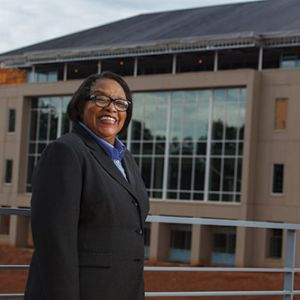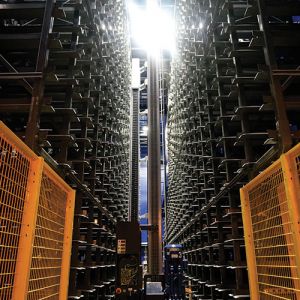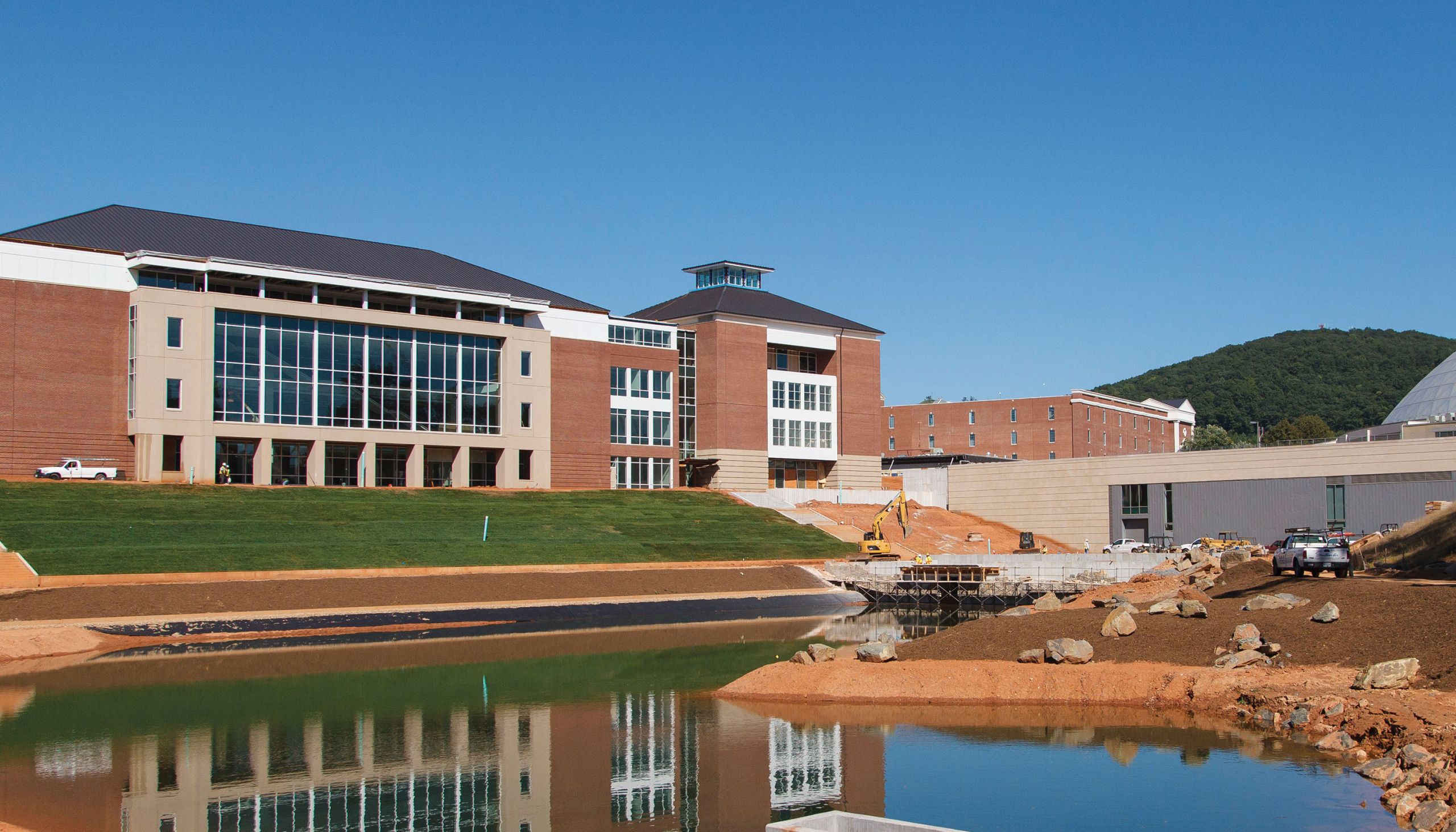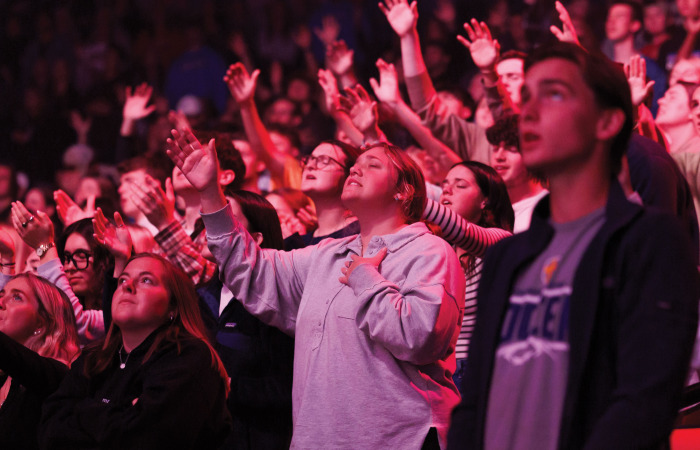Liberty University is taking its academic offerings to new heights — four stories to be exact — as construction on the Jerry Falwell Library nears completion.
The $50 million, four-story, 170,000-square-foot building is Liberty’s largest investment in any new structure to date and is the cornerstone of the university’s $400 million campus-wide rebuilding project.
Since breaking ground on March 7, 2012, and the installation of the final steel beam on Jan. 28 of this year, construction has continued to progress rapidly with interior work currently in full swing.
Scheduled to open in late 2013, this iconic building will become the academic epicenter for Liberty, ushering in a new era of excellence. Although completely cutting-edge in its technological offerings and innovative features, the architecture with many Jeffersonian features will be equally stunning, featuring modern artwork and interior design, and breathtaking views from its two balconies and five terraces.
The library consists of two buildings joined together by an indoor walkway and will include a rooftop garden. Inside it will feature plenty of natural light and creative interior design elements, including a four-story floating staircase beside large windows that overlook the south end of Liberty’s campus. It also includes a spacious, two-level food court, which will have a number of choices, including Starbucks, Pizza Hut, and sushi.
Stunning views surround the library on all sides, whether it is a newly created lake and green space to the south, the Blue Ridge Mountains to the west, or Liberty’s vast campus and mountain property to the north and east.
The library, named for Liberty’s founder, Dr. Jerry Falwell, Sr., will be a lasting testament to his vision and legacy. Located in the library will be the Jerry Falwell Archive, which will memorialize his life and ministry. President Jerry Falwell, Jr. is deeply involved in the design and scope of both the archive and the rest of the library.
To create this one-of-a-kind space, library staff and planners benchmarked a number of the nation’s most progressive libraries, gathering inspiration to make sure that Liberty’s is on par with the best in the country.

Marcy Pride, library dean
“We understand that when it comes to learning, one size does not fit all,” said Marcy Pride, Liberty’s library dean. “(In the new library) we can accommodate whatever style and whatever interests a person might have, while at the same time providing them a lovely environment in which to learn and explore.”
Pride, who took the helm in January, said her goal for the library is for it to be more than a massive warehouse for books, but rather a forum for knowledge, a place that “truly inspires.”
“The library is going to provide an opportunity for students to not only get information, but we hope and pray to also inspire them, to encourage creativity and innovation, and allow them to ask questions and proceed to answer them.”
The library will be as incredible in function as it is in design, she added, ensuring that students have access to the latest technological advancements.
The main entrance will feature a massive media wall, 24 feet wide and 13 feet high, which will display announcements, photos, and other postings both from the university and submitted by students. The wall will be interactive, with motion-activated navigation.
Four surface computers — touch-screen tabletops that operate like a tablet — will be displayed in various locations throughout the library for access to academic materials and journals.
The computer tables and media wall will use digital technology to connect the Liberty community. Students and faculty will be encouraged to submit photos and stories from mission trips, study abroad experiences, and local projects to be displayed along with other campus information and events.

The ASRS in the Jerry Falwell Library.
The highlight of the library’s technology is its robotic book retrieval system, the Automated Storage and Retrieval System (ASRS). Housed primarily in the basement of the building, the ASRS has three robots, which can store and retrieve up to 4,200 bins with a capacity of 420,000 items.
The system was developed by Muratec, a world leader in machine tool technology, and is the company’s first ASRS installation for a library.
Students will request items from the online catalog and pick them up at the library’s Customer Service Center. The process will only take a matter of minutes.
The ASRS will house more than 220,000 items when the library opens.
Although the bulk of the collection will only be accessible through the robotic system, students will still have direct access to about 65,000 newer and frequently used books in the library’s “main collection” — a four-story book tower and two-story reading room. The main collection will remain in the current library, located in Arthur S. DeMoss Learning Center, as the new library is completed.
Lowell Walters, associate dean of library technologies and collection services, said the goal is to create collections that are “both current and relevant in content, as well as in 21st century format,” and to make the resources available to the students as quickly as possible.
A new virtual browsing system will be launched this fall, allowing students to easily peruse titles in the ASRS; some will include the option of viewing the table of contents and chapters. A digital document delivery service for periodical articles is also being established.
This summer, more than 200,000 books were brought from the current library and off-site storage and loaded into the ASRS. To ensure that those titles remain available even as construction on the new library continues, requested books are being retrieved from the ASRS and delivered to the current library three times a day.
The new library will have a significant amount of space dedicated to interactive learning. This includes five learning commons, a scholars commons, computer commons, interactive classrooms, an assistive learning center, and more than 30 group study rooms. Across the library, visitors will have access to a number of scanners, printers, and computers.
“The library is really going to be a totally engaging place, no matter what your purpose is for coming,” Pride said. “Whether you want to get a book, read, write, or meet with a group to work on a project, there are going to be spaces to accommodate all these kinds of things.”
The group study rooms vary in size, accommodating up to 20 students, and feature a special paint that allows students to write on the tables and walls from floor to ceiling and then erase the work when they are done.
Many spaces in the library will offer interactive technology that allows for project collaboration, including furniture designed with built-in ports for electronic devices.
Individuals can plug their personal laptops into a “puck” (physically or wirelessly) and work together to simultaneously edit a document, which is displayed on a large screen. It also allows for HD video conferencing, allowing off-site group members to participate.
The interactive classroom will have multiple projectors and computers, which can be controlled by a professor so the same information appears on every screen.
“We will have so many opportunities to serve people that we haven’t had before,” Pride said. “The new library will benefit students tremendously in their ability to say what they need, find what they need, evaluate it once they find it, and then use it effectively and ethically.”
As people explore the expansive space, information kiosks will guide them to certain points in the library. Several staff members will also be walking throughout the building, assisting with technology and other inquiries.
The library will have a one-stop Customer Service Center for help on any topic, from general inquiries to in-depth assistance with research projects. New staff will include several “subject librarians” who specialize in a particular discipline and will be available during set hours each day.
Each semester the library will host a series of classes in the Research Assistance Classroom, where students can learn about a variety of topics that will enhance their ability to conduct effective research, such as using research citation methods (APA, MLA, etc.).
Pride, who holds M.A. and M.L.S. degrees, first worked for a library in the sixth grade. She now has nearly 20 years of professional experience in library work, including serving as a library director at colleges in Virginia and Maryland. She has also been a consultant for the Maryland State Department of Education. In 2002, her work won the American Library Association’s John Cotton Dana Award for Library Public Relations.
Pride has been putting her vast knowledge and experience into action as she works with her team to ensure that the Jerry Falwell Library is the heartbeat of the university for years to come.
“This is a great opportunity to exhibit a high level of service and to showcase the value that the library brings to the life of Liberty University. The experience that students have here will then impact their ability to be Champions for Christ,” she said. “It is not just about finding a book, it is about encouraging them and then having them go out and use what they have learned here to benefit themselves and others in ways that they couldn’t have before.”




